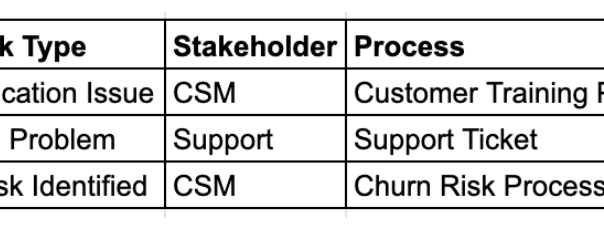— August 5, 2019
Collecting survey feedback from your customers is easier now than it has ever been before. Survey tools can help you to aggregate valuable information through email, chat, social media, and more.
But while collecting survey feedback is simple, the real value is in actioning that feedback. Having a consistent process to assess and assign action owners is not always a simple task.
In this article, we’ll show you how integrating a survey feedback action plan into your processes will help you improve your products and services, and show your customers you genuinely care about their success. Together, we’ll create a sample action plan that you can use for all of your survey feedback, whether it’s a single tweet or 10,000 responses.
Receiving actionable survey feedback
Your survey design, including the style and number of questions you use, can impact the quality of data you receive. You need to include questions which are likely to deliver actionable feedback.
For example, the question “Is the user interface hard to use?” is less likely to give you an action than the phrasing “What do you like least about the user interface?” The first example is a closed question, whereas the second allows the responder to describe their experience more accurately.
However, closed questions aren’t always bad, if used correctly. Net Promoter Score (NPS) is an excellent example of a closed question which many companies use to gauge customer sentiment. It is most useful when used in conjunction with a follow-up question such as “What is the reason for your answer?” NPS is just one example of a rating question with a free form text follow-up.
Asking a customer to score how they feel about a particular service offering, and then asking them why, is a style of questioning which can help you summarize data more easily, while still capturing actionable feedback.
Most importantly, every question needs to have an owner or stakeholder. The owner is one or more people within your organization who will be the consumer of any actions from the responses.
Depending on the size and scope of your survey, all questions may have the same stakeholder, but more often than not, you are asking questions about different services or product offerings and therefore need to include a cross-functional representation.
Actionable Plan Creation Step 1: Identifying your questions and response Owner(s)

Key elements of a survey feedback action plan
You now have created a survey that will result in detailed and actionable feedback. Before we dive into how to action the results, let’s examine what makes an effective plan.
There are three components of a good feedback action plan: Repeatability, traceability, and communication.
Repeatability
The process you use to action survey feedback must be repeatable. Surveying should not be a one-off event, and feedback can come from many different places.
Your process needs to be generic enough such that it can handle all of the comments and concerns of your customers efficiently, on a regular cadence, from any source. Therefore, it is best to use a lightweight process, which fits into a teams’ natural workflows.
Avoid a process with a lot of manual steps or dedicated meetings that involve many stakeholders—these will likely result in the process not being used. Instead, use existing processes such as product standups, defect tracking, roadmap planning, or market assessment meetings to notify stakeholders about relevant feedback.
In your action plan, identify the processes into which each response owner wants to have feedback submitted. The best survey action plans fit right into existing processes and remove any extra burden on any of the key stakeholders that need to review and action survey feedback.
Actionable Plan Creation Step 2: List processes used to action the survey feedback

In addition to each question having a stakeholder, some specific types of feedback require a different set of stakeholders. These are cases where the feedback already has a defined process associated with it.
For example: If a response to any question is clearly a user-education issue, a payment dispute, or a technical issue requiring investigation, you wouldn’t want to send that response to the specified question stakeholder, you should send that to the appropriate team that handles those types of issues.
Actionable Plan Creation Step 3: List defined processes for feedback falling into those categories

Traceability
There are two types of traceability to consider when building an action plan. The first is tracking which customer each piece of feedback comes from. Tracking your survey feedback in a CRM tool not only provides a logical customer-related place for you to view and action the data, but it also combines the feedback with other valuable metadata.
For example, customer size, spend, historic CSAT, location, market vertical, contract length, etc. Being able to report on your feedback against these data points can strengthen your insights and add context to the survey feedback.
For example: Are your longtime customers happier, or more concerned, with your current offerings? Do the customers in a particular region or vertical get more value from you? Questions like these are essential to help to drive change everywhere from your support hours to your marketing messages.
The second traceability concern is connecting the feedback to the actions you plan to take. Making sure all progress on actions is tracked will help provide a clear and reportable view into your survey program’s outcomes.
Just as you do not want new processes, you do not want there to be new tools for your stakeholders to monitor either. Use the existing tooling as much as possible to track progress on actions.
Actionable Plan Creation Step 4: List the tools used for tracking

Communication
Communication is a critical part of your actionable plan. Is your communication going to be internal, or will you give status updates to the customer?
Not all feedback necessarily requires looping-back with the customer, but when it does, you want to make sure it is clear who should communicate externally, what the message is, and when they should deliver it.
Listening to survey feedback is a crucial way to make customers happy and giving timely, personalized responses is a fantastic way to show you are listening.
Actionable Plan Creation Step 5: List who owns communication and when

Actioning survey feedback
You’ve completed your survey! You now have hundreds or thousands of lines of feedback which you need to analyze and action, you know which stakeholders are involved in those actions, and you have existing processes and tools in place that will allow you to monitor the actions efficiently.
So how do you go about using the actionable plan we created?
Group and categorize the data
Using your feedback tool, CRM tool, or a spreadsheet, you should start by grouping the survey feedback by any criteria you would like. Mass walls of free-form text can be hard to read, unstructured, and hard to correlate.
There are text analytics tools that can help pull out sentiment and keywords, or you can manually classify the data according to the areas on which the comments focus and the type of feedback.
Your categorization should include things like to which product, feature or service the survey feedback relates, and whether it is a compliment, a criticism, a bug, or an end-user education issue. It would be a lot of noise if each comment were delivered to the responsible stakeholders. Grouping helps to remove some of that noise for the most common themes.
Once you have the survey feedback categorized, you easily can determine which part of your actionable plan to use.
Examples:
If you received criticism in response to the question “Please rate your satisfaction with the on-boarding process” you would go to the line for that question in the action plan. From the plan you know that Professional Services will take a look at that, it should be added to their Trello agenda for their monthly Service Quality Meeting, and, when they have a response, the CSM will be responsible for sharing it.
Or if the feedback was a user clearly not understanding a specific feature in their response to “What are the things you like least about the product?”, it’s likely not feedback for the Product Management team, but rather an end-user education issue which should be sent to their Customer Success Manager.
Your actionable plan helps make it obvious where each group and category of feedback should be sent and tracked!
Observe trends and correlations
A great action plan not only feeds comments into the teams best suited to respond or address them, but it also serves as an opportunity to understand trends within your customer base. If you have your data inside a CRM tool, you can split the data by any metadata you collect on your customers.
Doing this analysis will derive even more value for your organization. For example, if you find that customers in one vertical use a particular feature more frequently than another vertical does, you might want to change your sales pitches to better suit the different use cases.
Or if you find that your newer customers are more frustrated with the product than your long term customers, there may be an on-boarding change you can make to help them be more successful. These observations are just as valuable as the original feedback itself.
Report to your organization
Your organization will benefit from understanding the good, the bad, and the ugly according to your customers. If you have created and used your actionable plan, grouped and categorized your feedback correctly, and spent time understanding the trends within the feedback, you can easily report on your customers’ overall sentiment.
These types of presentations also highlight the value of surveying customers and can help correlate with metrics such as a change in customer retention and satisfaction.
Building a report on feedback themes, changes in trends from previous surveys and any other noteworthy observations will help your company understand your customers better.
Why use an actionable plan?
The act of asking for feedback isn’t valuable on its own. Survey responses are only just words until something is done with them. Actioning survey feedback is one of the most impacting ways a company can improve its offerings. These insights came from the best people to tell you what works and doesn’t: those who use your products and services every day. A plan like the one we’ve created in this article is simple, clearly outlines the people and processes involved in actioning feedback effectively, and maintains ownership throughout. It allows you to report, not just on the feedback itself, but on the specific improvements you have made based on the feedback. Using an actionable plan on your survey feedback will help you to shape your roadmap, improve service offerings, save churn risk accounts, and bring more value to your customers.
Business & Finance Articles on Business 2 Community
(44)







